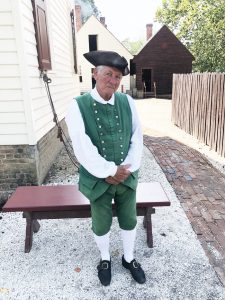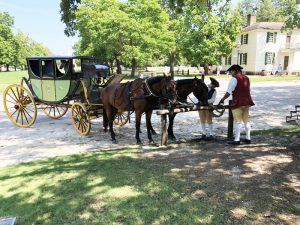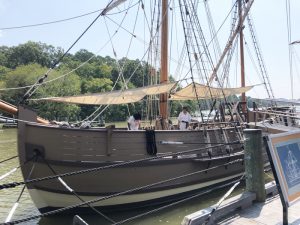By Fletcher Word
Sojourner’s Truth Editor
For the history buff, the student of American history, there may be no more fascinating place than the Historic Triangle – that site in southern Virginia where Williamsburg, Jamestown and Yorktown intersect. However, even if history is not a visitor’s strong suit, there are plenty of other fascinating aspects to the Triangle.
But let’s start with the history. It’s all around.
Jamestown became, in 1607, the first Virginia settlement and, in 1619, the site where the first enslaved people from Africa landed, foreshadowing the issue that would plague the New World for centuries to come.
 The Jamestown experience starts at the Visitor Center, one mile past the entrance gate and across the causeway connecting the mainland to the island. In the Visitor Center you can view the history of the events that brought the English settlers, and the Africans they enslaved, to the Virginia colony.
The Jamestown experience starts at the Visitor Center, one mile past the entrance gate and across the causeway connecting the mainland to the island. In the Visitor Center you can view the history of the events that brought the English settlers, and the Africans they enslaved, to the Virginia colony.
Then, cross the footbridge and take a walking tour of the island and the reconstructed original settlement. View re-enactments of the lives of the first settlers.
Williamsburg was founded in 1632 on the high ground between the James and York rivers. The town served as the capital of Virginia from the late 1600s until 1780 and was the center of political events in the state leading up to the Revolution.
The village has been reconstructed and visitors, after a tour of the Visitor Center, can take buses to the village and tour the huge sprawling display of houses, churches, exhibits and colonial folks who will explain exactly what is on view.
It’s a breathtaking reconstruction – plan to spend a good portion of your day there.
 Listen, you just can’t get enough history in the Historic Triangle. Yorktown on the Chesapeake Bay is the site of the decisive battle of the Revolutionary War.
Listen, you just can’t get enough history in the Historic Triangle. Yorktown on the Chesapeake Bay is the site of the decisive battle of the Revolutionary War.
Hearing that the Brits were trapped there because the Americans’ French allies’ fleet had them penned in, General George Washington force marched his troops down from their New York headquarters. Washington and his troops and French allies arrived in September of 1781 and completely surrounded the army of British General Cornwallis who surrendered on October 19.
The surrender prompted negotiations between the British and Americans which culminated in The Treaty of Paris of 1783.
And, yes, there is a replica of old Yorktown so visitors can experience times during the Revolutionary period. The American Revolution Museum, the Yorktown Battlefield and the Yorktown Beach all are awaiting you.
But, what it history just doesn’t do it for you?
 Then go to the historic triangle for the lovely scenery, for the food, for the churches, for the farmers’ markets, for the food, for the Riverwalk Landing, for the beauty of the College of William and Mary, for the food, for Busch Gardens, for the holiday celebrations and parades … and did I mention the food?
Then go to the historic triangle for the lovely scenery, for the food, for the churches, for the farmers’ markets, for the food, for the Riverwalk Landing, for the beauty of the College of William and Mary, for the food, for Busch Gardens, for the holiday celebrations and parades … and did I mention the food?
So much fresh seafood, in so many restaurants with gorgeous views of the rivers or the cities. Add a little adventure to your trip and take a drive south on Interstate 64 to Norfolk and go over the bridge to the Eastern Shore and find yourself a restaurant overlooking the Chesapeake Bay to sample some seafood and drink in the glorious view. The Oyster Farm Restaurant in Cape Charles, for example.
The restaurant offers outdoor patio seating – breathtaking view of the Bay, delicious food, a short drive from the downtown Cape Charles area which, in itself, is worth a walkabout, to view the shops and galleries.
Then, back to the Williamsburg area.
Plan on a long weekend in the Historic Triangle. A week is better. And plan on revisiting the rea in a couple years, to see again the history, to soak in the scenery, to rediscover one of America’s most important, most interesting sites.
However much time you spend in the Triangle, it will be time well spent!






